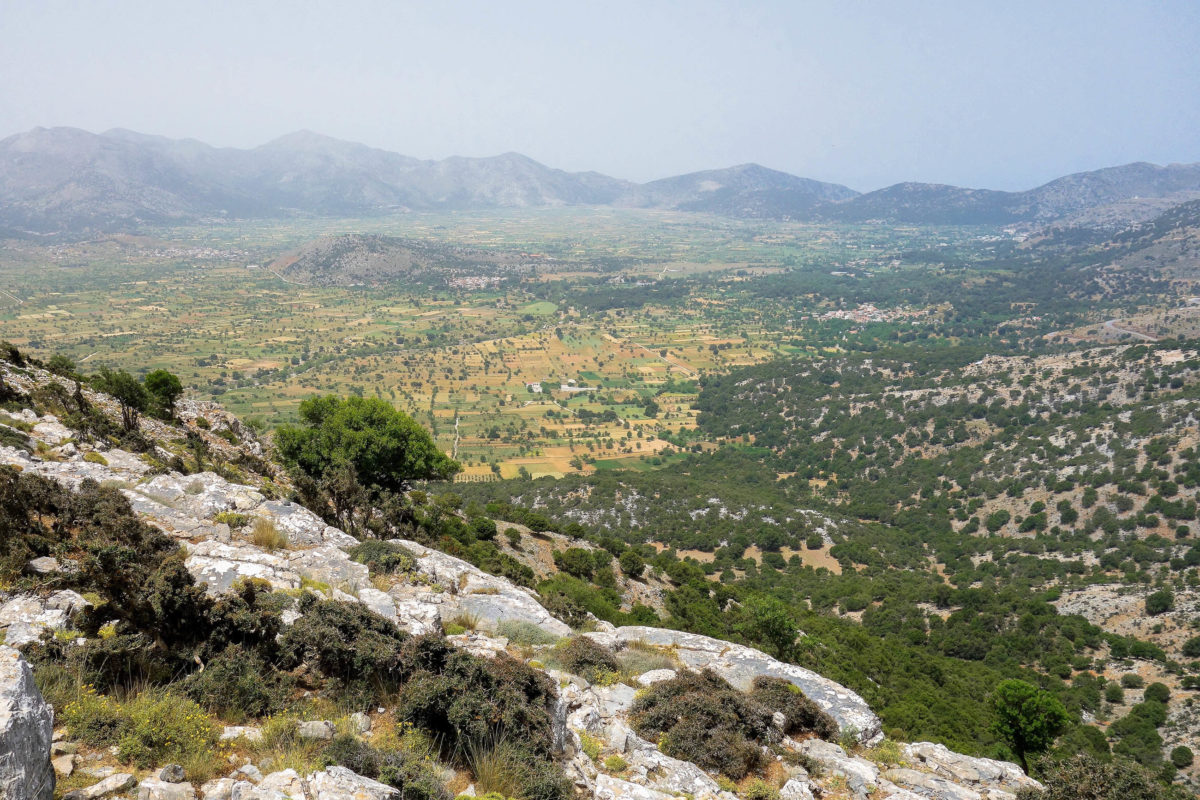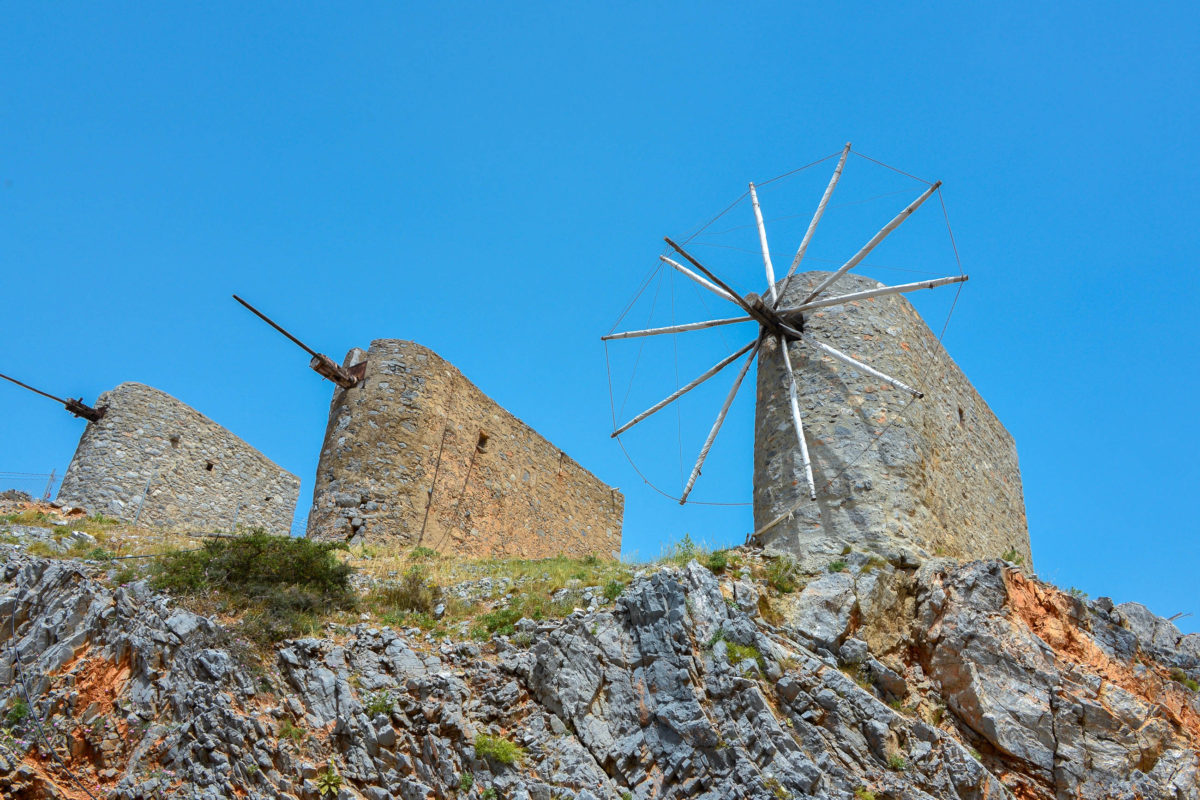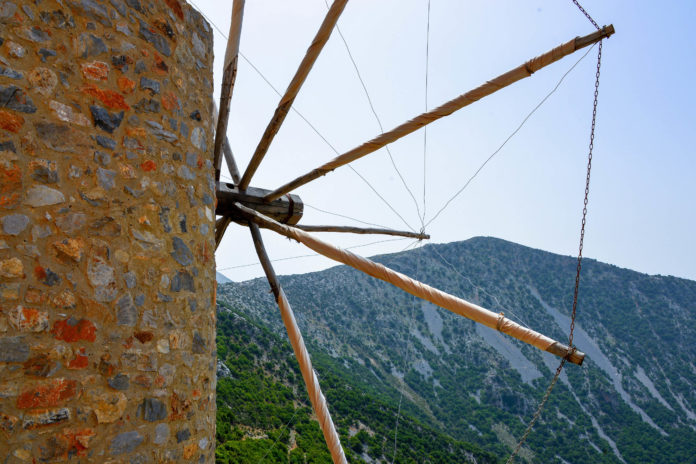Die von Landwirtschaft geprägte Lassithi-Hochebene im Herzen von Kreta bietet vor allem Frieden, Stille und Erholung im Grünen. Zu ihren bekanntesten Sehenswürdigkeiten gehören ihre Windmühlen und die Geburtshöhle von Göttervater Zeus.
Die Lassithi Hochebene auf 830 Metern Seehöhe liegt rund 70km westlich von Heraklion und ist die fruchtbarste Region und die größte Hochebene auf Kreta. Sie ist ca. 10km lang und 7km breit und beherbergt rund 20 Dörfer, in denen etwa 5.000 Menschen leben.
Der Grund der Ebene wird seit der Antike für die Landwirtschaft genutzt, die Häuser wurden deshalb alle an die Flanken der umliegenden Berge gebaut. Bis heute werden hier Getreide, Kartoffeln, Bohnen, Obst und vieles mehr kultiviert. Die so genannten „linies“, mit denen die Venezianer die Felder einteilten, sind heute noch zu sehen.
Anfahrt zur Lassithi Hochebene

Die Anreise zur Lassithi Hochebene kann über zwei Passstraßen von Agios Nikolaos und Chersonissos aus erfolgen. Von hier und auch von Heraklion aus bestehen 1-2mal täglich Busverbindungen zur Lassithi Hochebene. Die meisten Hotels bieten organisierte Touren zur Lassithi-Hochebene an, die abgesehen vom Ausflug mit dem Mietwagen, am meisten Zeit vor Ort bieten.
Von den Passhöhen auf rund 1.100 Metern tut sich bereits ein atemberaubender Blick über die von Gipfeln umrahmte Ebene auf. Rund um die Ebene führt eine 23km lange Ringstraße – ideal für die Erkundung ihrer Sehenswürdigkeiten!
Sehenswürdigkeiten auf der Lassithi Hochebene
Wer auf der Lassithi Hochebene nächtigen möchte, tut dies am besten in Tzermiadon. Dieser kleine Ort ist mit kleinen Pensionen und gemütlichen Tavernen so etwas wie das touristische Zentrum der Region. Viel los ist hier allerdings so gut wie nie.
Tipp: Zu Beginn und Ende der Saison sollte für die Lassithi Hochebene warme Kleidung eingepackt werden, denn die Nächte können bereits sehr frisch sein. Im Winter ist ein halber Meter Schnee in dieser Höhe keine Seltenheit!
Die Sehenswürdigkeiten der Lassithi Hochebene können alle mit dem Auto besucht werden. Zwischen den Feldern führen keine Straßen, dafür aber Wanderwege hindurch. Am flachen Teil der Ebene gibt es aber außer Ackerland kaum Interessantes zu sehen. Die echten Highlights der Lassithi Hochebene liegen ebenso wie die Siedlungen an den Berghängen.
Höhle von Psychro (Diktäische Höhle) – Zeus‘ Geburtsstätte
Der griechischen Mythologie zufolge soll hier der mächtige Göttervater Zeus von seiner Mutter Rhea geboren und von der Ziege Amaltheia mit dem berühmten Füllhorn ernährt worden sein (eine Höhle auf der Nida-Hochebene behauptet dies übrigens ebenfalls von sich). Auch der berühmte kretische König Minos, Namensgeber der minoischen Kultur, soll hier von Zeus und Europa gezeugt worden sein.
Belegt ist, dass die Höhle von Psychro von den Minoern, Europas erster Hochkultur, als Kultstätte genutzt wurde. Zahlreiche Votivgaben, Bronzefiguren von gottgleichen Männern und Frauen sowie Opferaltäre wurden hier gefunden.
Die Diktäische Höhle verfügt über einen eigenen (kostenpflichtigen) Parkplatz, der zur Hochsaison oft hoffnungslos überfüllt ist – Zeus’ Geburtshöhle ist mittlerweile ein gewaltiger Touristenmagnet! Vom Parkplatz führt ein etwa 15minütiger, ziemlich steiler Pfad zum Eingang der Höhle, wo noch einmal Eintritt verlangt wird. Wer diesen nicht gehen möchte, kann – natürlich auch gegen Gebühr – auf Mauleseln reiten.
Tipp: Wer in der Hochsaison den größten Touristenansturm meiden möchte, sollte die Zeus-Höhle vor 11:30 Uhr oder nach 17:00 Uhr besuchen.
In der Höhle selbst ist es angenehm kühl, es gibt einen künstlichen See, Tropfsteine hängen von der bis zu 15m hohen Decke und kleine Vögel und Fledermäuse zischen durch die Dunkelheit. Rund 20 Minuten dauert der Rundgang, dann hat man auch schon wieder alles gesehen – Zeus wird sich wohl eher nicht zeigen…
Karfi – Sitz von Ariadne
Ebenfalls in der griechischen Mythologie verankert ist die Ortschaft Karfi. Hier soll Ariadne gelebt haben, Prinzessin und Tochter von König Minos. Sie soll Theseus den berühmten Ariadne-Faden übergeben haben, damit dieser nach seinem erfolgreichen Kampf mit dem Minotaurus wieder aus dem Labyrinth heraus findet. Heute ist Karfi eine interessante Ausgrabungsstätte der minoischen Kultur und bietet einen dramatischen Blick über Nordküste Kretas.
Windmühlen der Lassithi Hochebene

Einst standen rund 8.000 Windmühlen mit ihrem charakteristischen weißen Segeltuch auf der Lassithi Hochebene. Sie betrieben die Grundwasserpumpen zur Bewässerung der weitläufigen Felder. Heute laufen die meisten Pumpen elektrisch, dennoch sind einige historische Windräder noch erhalten. Besonders gut gepflegt werden die meisten von ihnen allerdings leider nicht.
Kronos-Höhle
Für Hobby-Archäologen ist auch die Kronos-Höhle interessant. Sie liegt rund 2km vom Dorf Marmaketo entfernt und ist die älteste religiöse Höhle der Lassithi-Hochebene. Wie Funde von Figuren und Keramik beweisen war die Höhle bereits in der Jungsteinzeit bewohnt und wurde auch als Grabstätte genutzt. Auch einige Minoer wurden hier mit kunstvollen Grabbeigaben bestattet.
Für Besucher ist die Kronos-Höhle kaum erschlossen, auf dem nur behelfsmäßig befestigten, rutschigen Boden ist eine Taschenlampe empfehlenswert. Um die steinzeitlichen und minoischen Gräber zu entdecken zahlt sich außerdem ein Führer aus.
Volkskundemuseum in Agios Georgios

Wer sich für Kretas Vergangenheit interessiert, sollte auch im Volkskundemuseum in Agios Georgios einen Zwischenstopp einlegen. In einem originalen traditionellen Bauernhof wird das karge Leben der Bauern auf der Lassithi-Hochebene in den vergangenen Jahrhunderten vorgestellt. Das Museum ist nur in der Sommersaison geöffnet.
Kloster Vidani
Ein wunderbarer Ort des Friedens und der Einkehr ist das malerische Kloster Vidani aus dem Jahr 1841. Es liegt in der Nähe der Ortschaft Kato Metohi am Fuße des Bergs Louloudaki und ist der Zodoho pigi, der „lebensspendenden Quelle“ geweiht.
Demnach gruppieren sich seine Gebäude um einen fröhlich plätschernden Brunnen inmitten von blühenden Beeten und Zypressen. Ein nettes Café lädt zum Verweilen und ein kleines naturgeschichtliches Museum, welches von der Universität von Kreta geführt wird, informiert über die regionale Flora und Fauna.
Kloster Kera Kardiotissa
Das schmucke Marienkloster Kera Kardiotissa schmiegt sich in den Nordhang des Dikti-Gebirges einige Kilometer von der Lassithi Hochebene entfernt. Die kleine Klosterkirche stammt aus dem 14. Jahrhundert und beeindruckt durch ihre farbenfrohen Fresken, die zu den besterhaltenen Kretas gehören. Während der Türkenherrschaft diente das Kloster als geheimer Treffpunkt und Schule der Griechen.





